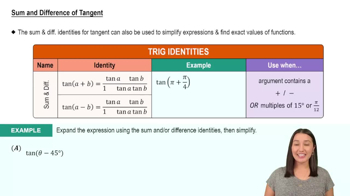Use the result from Exercise 80 to find the acute angle between each pair of lines. (Note that the tangent of the angle will be positive.) Use a calculator, and round to the nearest tenth of a degree.
x + y = 9, 2x + y = -1
 Verified step by step guidance
Verified step by step guidance Verified video answer for a similar problem:
Verified video answer for a similar problem:



 6:14m
6:14mMaster Sum and Difference of Sine & Cosine with a bite sized video explanation from Patrick
Start learning